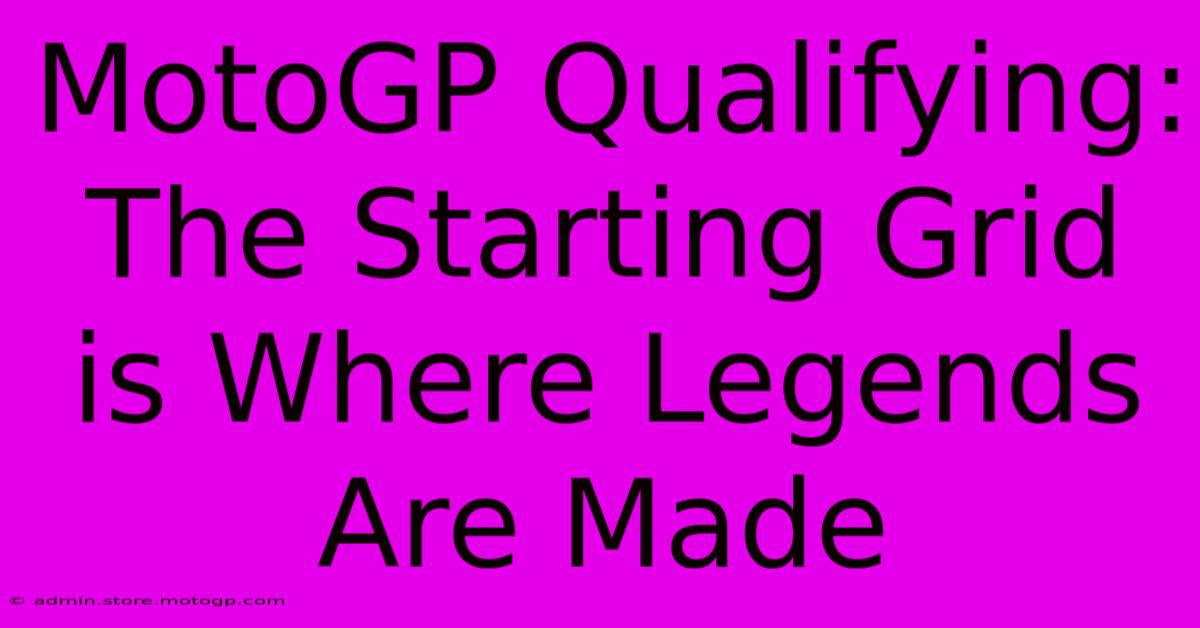MotoGP Qualifying: The Starting Grid Is Where Legends Are Made

Table of Contents
MotoGP Qualifying: The Starting Grid is Where Legends Are Made
MotoGP qualifying. The very words conjure images of screaming engines, tire smoke, and the nail-biting tension of riders pushing their machines – and themselves – to the absolute limit. It's not just about setting a fast lap; it's about securing the perfect starting position, the launchpad for a potential race victory and a crucial step in shaping the legend of a MotoGP rider. This is where the drama unfolds, where reputations are forged, and where legends are made.
The Pressure Cooker: Understanding the MotoGP Qualifying Format
The current MotoGP qualifying format is a finely tuned system designed to maximize excitement and deliver a thrilling spectacle for fans. It’s a multi-stage process, starting with FP1 and FP2, the free practice sessions where riders get to grips with the track and dial in their bikes. These sessions are crucial for data gathering and setting a baseline for the weekend's performance.
Then comes FP3, the third free practice session, which is particularly important because the combined times from FP1, FP2, and FP3 determine who progresses directly to Q2. The top 10 riders based on their combined times automatically secure their place in Q2, while the remaining riders must fight it out in Q1.
Q1 is a high-stakes session. The pressure is immense, as only the two fastest riders from this session get to advance to the all-important Q2. It's a brutal elimination round, where even the slightest mistake can cost a rider dearly.
Q2 is where the true battle for pole position begins. The top 10 riders from FP3 are joined by the two qualifiers from Q1, making it a fierce competition of 12 riders vying for the coveted pole position. This session sets the starting grid for the race, determining who gets that vital advantage at the start.
More Than Just Speed: The Art of MotoGP Qualifying
MotoGP qualifying is more than just about brute speed; it's a complex interplay of several crucial factors:
Track Knowledge and Conditions:
Understanding the track's nuances, including its bumps, camber, and braking points, is crucial. Similarly, the ever-changing conditions – temperature, humidity, wind, and track temperature – significantly impact tire performance and require riders to constantly adapt their riding style and machine setup. A rider's ability to analyze and react to these dynamic variables is key.
Tire Management:
MotoGP qualifying is a delicate balance between pushing for the fastest lap and conserving tires for the race. Riders need to find the optimal window for performance, extracting maximum grip from their tires without wearing them out too much. It’s a strategic game of risk versus reward.
Bike Setup:
The meticulous tuning of the bike's suspension, electronics, and engine mapping are critical to maximizing performance. The slightest adjustment can make a significant difference in lap time. The team's engineers play a crucial role in providing the rider with the best possible setup.
Slipstream:
Drafting, or slipstreaming, another rider's bike is a common strategy during qualifying. The slipstream reduces air resistance, providing a significant speed boost and making it a crucial element of any competitive lap. Mastering slipstreaming requires precise timing and positioning.
The Legacy of Qualifying: Shaping MotoGP History
The starting grid in MotoGP is far from inconsequential. A good starting position significantly increases a rider's chances of victory, allowing them to avoid early-race chaos and potentially dictate the race pace. Many legendary races have been shaped by the events of qualifying. Think of Marc Marquez's incredible pole positions and race-winning starts, or Valentino Rossi's masterful ability to navigate the early laps from seemingly any position. These are all testaments to the importance of qualifying in shaping a rider's legacy.
Conclusion: A Crucible for Champions
MotoGP qualifying is a high-pressure, high-stakes battle of skill, strategy, and nerve. It's a spectacle that showcases the very best of motorcycle racing, where the pressure to perform is immense and the rewards for success are immeasurable. The starting grid isn't just a grid; it's a launchpad to victory and a proving ground where MotoGP legends are made. The roar of the engines, the smell of burning rubber, and the intensity of the competition – these are the elements that make MotoGP qualifying an unforgettable experience for fans worldwide. It’s a true crucible for champions.

Thank you for visiting our website wich cover about MotoGP Qualifying: The Starting Grid Is Where Legends Are Made. We hope the information provided has been useful to you. Feel free to contact us if you have any questions or need further assistance. See you next time and dont miss to bookmark.
Featured Posts
-
The Insiders Austin F1 Map Tips And Tricks For Navigating Cota
Feb 20, 2025
-
Austin Sprint Race Time Building Confidence Through Competition
Feb 20, 2025
-
The Ultimate Guide To Moto Gp Helmets
Feb 20, 2025
-
Austin Motorcycle Race Everything You Need To Know
Feb 20, 2025
-
Ride With Confidence The Protection Of A Moto Gp Helmet
Feb 20, 2025
